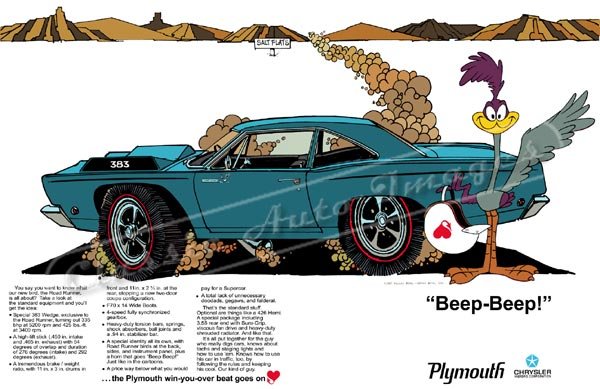michformulaS
Well-Known Member
I don't think a nice 1968 B body 383 car is worth twice as much as the 1968 340 A body today in the same condition. They seem to be worth about the same today as they were back then.
My point was, that the 383/335 HP engine was over-rated for Horsepower. Not
that it was a bad engine.
More to come,,,,,,,,,,,
In 1968, just like in 2013 the mid size car is what a majory was buying if buying a car. No matter how you slice it in equal cars in stock from the 383 was quicker then a 340. Are you claiming that a 68 340s was qucker then a 383s? How come the giant killer 340 wasn't killing that giant? Or in 71 was a 340 roadrunner quicker then a 383? Finally who was smarter back in 1968 paying a few hundered more for a roadrunner when its worth almost twice a 340 a body. I love my 68 Barracuda but I would also love a 68 Roadrunner just as much, I just can't afford a 68 roadrunner!

383 'The Numbers'
1967 383
325 HP @ 4800 RPM
425 Ft/Lbs of Torque @ 2800 RPM
10.0 -1 Compression
Piston @ .014 Below Deck
Camshaft
.425/.437 Lift ~ 256*/260* Duration ~ 32* Overlap
Valve Springs = #134 lbs. Valve Closed / #208 lbs. Valve Open
Cylinder Heads
#2406516
2.08" Intake / 1.60" Exhaust
Combustion Chamber (Closed) = 73.5 CC's
Intake Manifold
#2205968
Low-Riser Dual-Plane
Bore Holes = 1 7/16" Primary / 1 9/16" Secondary
Carburetor
Carter AFB
1 7/16" Primary ~ 1 9/16" Secondary
575 CFM
Exhaust Manifolds
2.25" Header Outlet Opening
Style - Down-Angle w/Short Header
Exhaust Piping = 2.25" Primary/ 1.88" Secondary
------------------------------------------------------------
1968 '383' Road Runner
335 HP @ 5200 RPM
425 Ft/Lbs of Torque @ 3200 RPM
10.0-1 Compression
Piston @ .021 Above Deck
Camshaft
.450/.458 Lift ~ 268*/284" Duration ~ 46* Overlap
Valve Springs = #129 lbs. Valve Closed /#280 lbs. Valve Open
Cylinder Heads
#2843906
2.08" Intake / 1.74" Exhaust
Combustion Chamber (Open) 79.5 CC's
Intake Manifold
#280631
Low-Medium Riser Dual-Plane
Bore Holes = 1 11/16" Square-Bore Carburetor Base
Carburetor
Carter AVS
1 7/16" Primary / 1 11/16" Secondary
625 CFM
Exhaust Manifolds
2.25" Header Outlet Opening
Style - Wind-Swept w/Extended Header-type Passages
Exhaust Piping = 2.25" Primary / 2.25" Secondary
-----------------------------------------------------------------------------------------------------------------
Note; According to Chrysler, the 1968 383/335 HP Road Runner Engine put out only +10 Horsepower over
the 1967 383/325 HP Engine.


the '68 hemi darts ran 10.30's in the 1/4.
dont forget they also made 100's of 440 darts and 383 darts.
all of them would stomp the snot out of the 340 cars.
nuff said.
Super Stockers In Action
Tested a new 1968 Barracuda 340/275 HP in November 1967
1968 Barracuda 340-S
3.23 Gear-Ratio w/Sure-Grip
4-Speed
14.73 @ 96.7 MPH
